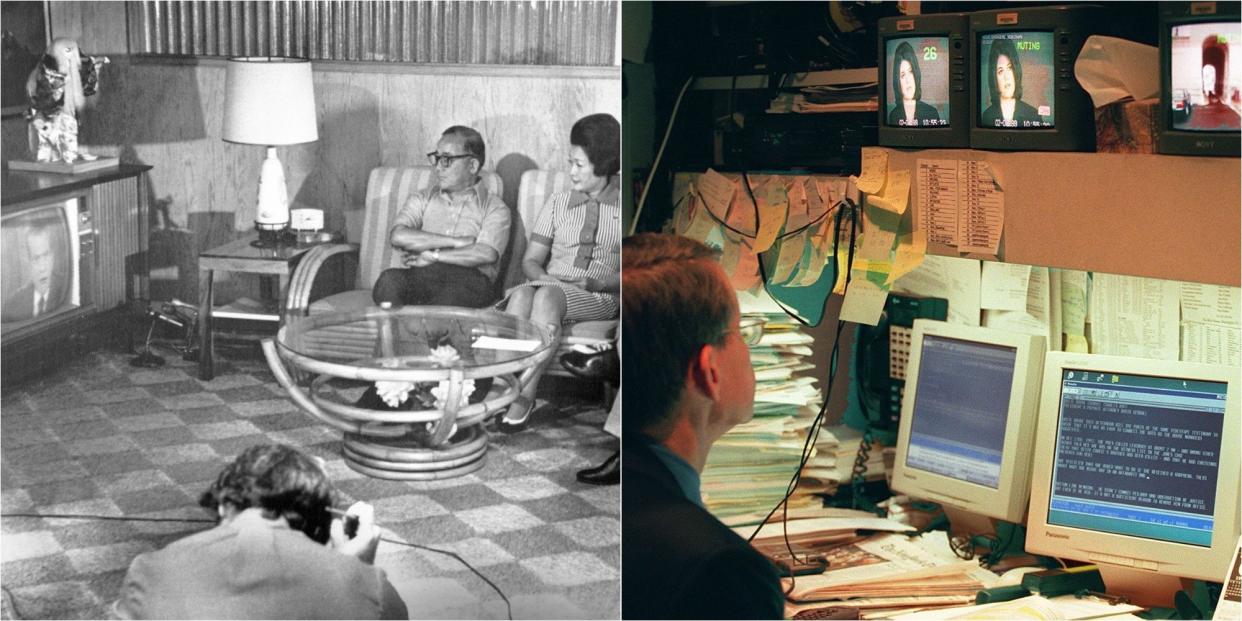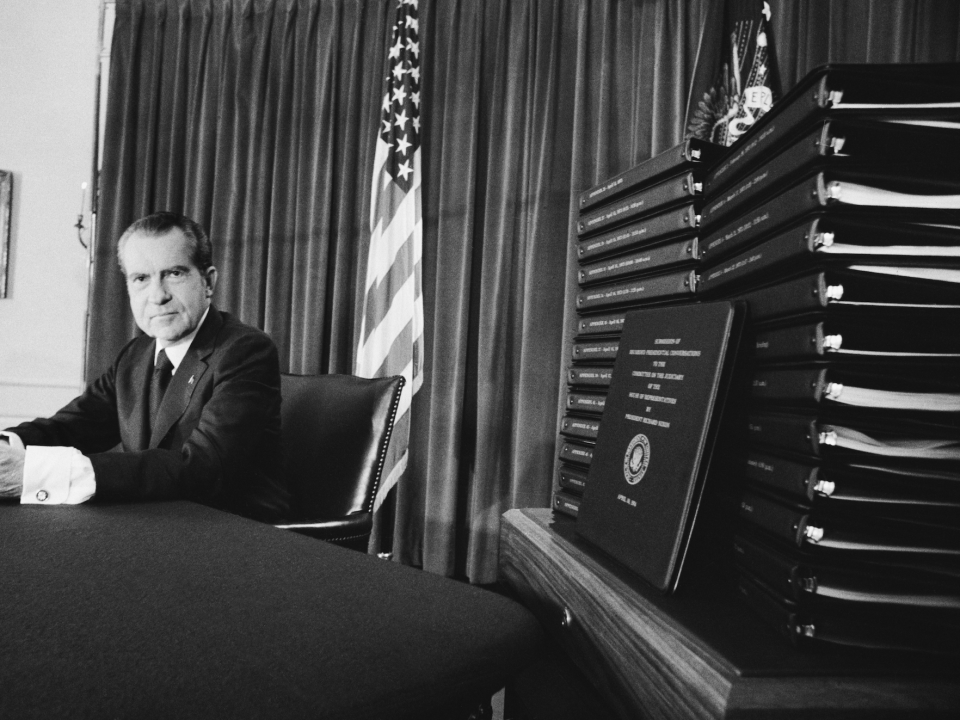Historic photos show the differences between Nixon, Clinton, and Trump's impeachment hearings

Bettmann Archive/Getty; William Philpott/AFP/Getty
President Donald Trump's impeachment hearing went public on Wednesday, and it's a foreign landscape compared to the two presidents who went before him.
He's the fourth president to face impeachment proceedings, after Richard Nixon, Bill Clinton, and Andrew Johnson. But Johnson's was hugely different since it took place in 1868.
For Nixon, since coverage was mostly in television and print, it was communal, and the nation gathered together to watch his hearings unfold on primetime TV.
For Clinton, television news was becoming more politicized, and the internet and talk radio were just beginning to flourish.
A president facing impeachment might be America's greatest drama.
President Donald Trump's impeachment hearing went public this week, and it's a foreign landscape compared to the two presidents who went before him.
It won't be the communal experience of a nation watching, like it was with former President Richard Nixon. But it's still going to hold the nation's attention.
Already, Trump's received some advice from former President Bill Clinton, who knows what the process is like. On Thursday, Clinton told CNN's Jake Tapper his advice for Trump was to get on with his job. "My message would be, look, you got hired to do a job," he said. "You don't get the days back you blow off. Every day is an opportunity to make something good happen."
In 1973, when the Watergate impeachment hearing was happening, America only had three television networks. It's estimated that 80% of Americans tuned in for at least part of the telecasts. Variety called it "the hottest daytime soap opera."
When Clinton's impeachment proceedings were broadcast in 1998, television news had become politicized and diversified, and the internet was in its infancy. It was the first proper ratings competition for CNN, Fox News, and MSNBC.
For Trump, there'll be no singular television audience. Instead there'll be a direct channel to the president through his Twitter account. There'll be live-streaming, blog updates, and 24/7 news. It's going to be a spectacle.
These historic photos show what the last two impeachment proceedings looked like, and how they compare to Trump's.
In the summer of 1973, millions of Americans gathered in their living rooms to watch former President Richard Nixon's impeachment hearings on television at 8 p.m. ET for weeks on end.

Bettmann Archive/Getty
Sources: Washington Post, Senate
Almost 25 years later, in 1998, America still watched former President Bill Clinton's impeachment hearings, but they did it from a variety of places. No more popcorn on the couch — people could work out while watching the latest developments.

Stan Honda / AFP / Getty
Source: Forbes
With Nixon, people become obsessed, watching the saga unfold day after day, seeing disclosures about the cover-up to get dirt on his political opponents come one after another that summer. They got to decide who was the villain and who was the hero.

Ernst Haas / Getty
Source: Washington Post
Clinton's impeachment proceedings were less about villains and heroes. The special counsel Ken Starr's probe into Clinton's real estate investments morphed into an investigation into his affair with former White House intern Monica Lewinsky.

The White House/AP
Updates on Watergate came through the television, or in newspapers. Variety called the hearings the "hottest daytime soap opera." ABC, CBS, NBC, and PBS televised the hearing. But while most networks rotated coverage to make space for soap operas and game shows, PBS televised all 250 hours.

AP
Source: CBC
Since Fox News and MSNBC had only launched in 1996, Clinton's televised hearing became the first proper ratings competition between the three networks, including CNN, which launched in 1980. All three rose during the heights of the hearing, and all three networks' ratings dropped right after the trial.

Terry Ashe/The LIFE Images Collection / Getty
Source: Forbes
PBS anchor Robert MacNeil said the televised broadcast of Nixon's impeachment was a Shakespearean drama. "The forces hostile to the king are rising on all sides," he said, as "messenger after messenger rushes in with bad news."

Denver Post / Getty
Source: Washington Post
Clinton's impeachment, by contrast, was a strange time for the media and the public. Some felt queasy about having a national debate over the president's sex life.

David Hume Kennerly / Getty
Source: The New York Times
But as the editor in chief of The American Spectator said, "If you have a tabloid president, you're going to be tabloid."

Adam Butler / AP
Source: The New York Times
The key piece of evidence of Nixon's wrongdoing was secret White House tapes, edited transcripts of which are seen here. He refused to release them, only acquiescing after the Supreme Court ruled he had to turn them over to Congress.

Bettmann / Getty
Clinton's inquiry was summarized by the reveal of Lewinsky's semen-stained dress. The dress destroyed his claim that he'd never had sexual relations with her.

Hulton Archive / Getty
Source: The Washington Post
Dramatic testimonies were given about burglaries and lies, and Nixon struggled to communicate his own message to the public. In retrospect, some people thought Nixon was buried by the controversy because he talked about it so often.

Bettmann / Getty
Sources: The Washington Post, The Washington Post, The New York Times
Clinton and his staff didn't make that same mistake. They tried to do their jobs and never talk about it. The New York Times reported that Clinton's chief of staff John D. Podesta told staff he'd break their necks if they talked about Lewinsky. In Clinton's 1998 State of the Union address, he didn't mention his scandals at all.

Douglas Graham / Congressional Quarterly / Getty
Source: The New York Times
Television and print journalists flocked to the spectacle around Nixon.

David Hume Kennerly / Getty
Sources: The Washington Post, Forbes
And it was the same for journalists covering Clinton.

Mario Tama / AFP / Getty
Sources: Forbes, Politico, The Washington Post
Except his impeachment trial happened during the boom of the internet. For the first time, people could find salacious details about a president's love life online. And news was unfolding in real time there. The Drudge Report, an online news site, broke the story about the Lewinsky affair before Newsweek.

William Philpott / AFP / Getty
Sources: Forbes, Politico, The Washington Post
The other big player was talk radio. In 1987, the FCC had abolished a rule requiring broadcasters to provide multiple perspectives on issues, allowing politically leaning radio personalities like Rush Limbaugh to rise to prominence. It changed the way news was delivered. Radio hosts like G. Gordon Liddy could joke crassly about Clinton sitting in the "Oral Office."

Mark Peterson / Corbis / Getty
Source: Forbes
There were similarities between the hearings themselves, too. Those working on Nixon's hearing weren't extraordinarily diverse back in 1973.

Bettmann / Getty
They weren't much more diverse in 1999.

Scott J. Ferrell/Congressional Quarterly/Getty
Lengthy petitions were hand delivered. This one, demanding Nixon's impeachment, was filled with 10,000 signatures and went for 80 yards.

Hulton Archive / Getty
Here, a woman stacks boxes filled with letters and petitions urging Congress to stop impeaching Clinton and censure him instead.

Paul J. Richards / AFP / Getty
Transcripts of Nixon's Watergate conversations were so bulky the men appear to be struggling to carry them.

Bettmann / Getty
Evidence for Clinton's hearing came in large boxes, just like with Nixon.

Joe Marquette / AP
As Nixon's inquiry progressed on television, the public wanted him to be impeached more and more, politics professor Arthur Sanders told the Washington Post.

AP
Source: The Washington Post
Nixon did have his supporters. This group prayed and fasted while the House Judiciary Committee continued its impeachment inquiry. But they weren't the majority.

Bob Daugherty / AP
In comparison, as Clinton's impeachment hearing progressed, he had most of America on his side.

Nick Ut / AP
Source: Washington Post
Although he didn't have everyone. Here, protesters demanded his impeachment, with one sign reading, "Impeach Butthead."

Paul J Richards / AFP / Getty
Source: The Washington Post
For Clinton, as the coverage of the trial continued, the nation's interest wavered. By the time the Senate voted on impeachment, more people were watching the NFL on CBS than the combined total of viewers watching the vote on all of the other networks.

Scott J. Ferrell/Congressional Quarterly/Getty
Source: Los Angeles Times
Nixon didn't lose attention in the same way. When he resigned to avoid being impeached, there were more than 60 million copies of weekday newspapers in circulation. Here tourists read a historic headline: "Nixon Resigning."

Bettmann / Getty
Source: Forbes
When the Senate acquitted Clinton, it was also on every newspaper front page.

Ed Betz / AP
On August 9, 1974, 110 million viewers tuned in to watch Nixon resign. At that time, it was the most-viewed show ever, except for the Apollo 11 moon landing. The population of the US that year was 214 million.

Keystone / Hulton Archive / Getty
Sources: Los Angeles Times, US Census
After Clinton was acquitted, NBC's jumbotron in New York's Time Square declared the president was "Not Guilty."

Timothy A. Clary / AFP / Getty
People on the streets took a moment to let it sink in.

Timothy A. Clary / AFP / Getty
Now, it's Trump's turn. On Wednesday, the House of Representatives launched public hearings about whether he should be impeached. They're being televised, because the Democrats want to take control of the news cycle and garner as much support as they can get before formally impeaching him.

Patrick Semansky / AP
Sources: Reuters, BuzzFeed News
Differences are already noticeable. Journalists' notepads have been put aside for the recording functions of their phones.

J. Scott Applewhite / AP
Viewers will be able to stream the hearings on their phones and laptops, from a variety of networks, including Fox News, MSNBC, CNN, and C-SPAN throughout the day, plus YouTube. Social media and news sites will deliver a constant flow of information.

Sarah Silbiger/Getty Images
Follow along here for live updates on the Trump impeachment hearings »
But some are worried about the coverage. Journalists Michael Winship and Bill Moyers, who worked for PBS during Nixon's reign, called on PBS to broadcast the hearings, like they did with Nixon, in a full-page New York Times ad. However, a spokeswoman for PBS said "we live in a vastly different media universe than we did 45-plus years ago."

Jim Spellman / WireImage / Getty
Source: Washington Post
C-SPAN started in 1979, so it didn't exist during Nixon's impeachment hearings. It broadcast Clinton's, though, and is broadcasting Trump's.

C-SPAN
Source: C-SPAN
Trump has already been harnessing social media to ensure he keeps his base locked down. His daily output on Twitter will add another dimension as the hearing goes public.

Donald J. Trump/Twitter
Sources: Washington Post, Los Angeles Times
Fox News' coverage could also change the public's perception. Since 2002 it's been America's most-watched cable network. And it's going to be providing two forms of coverage, one during the day of factual news, and one by night, from its opinion hosts like Tucker Carlson, which will likely spin things in Trump's favor.

Fox News
Sources: Adweek, The Guardian
What happened to Nixon and Clinton is important for Trump's future. Sanders told the Washington Post that Democrats are hoping for a repeat of the Nixon model, while Trump's hoping for a repeat of the Clinton one.

Official White House Photo by Shealah Craighead
Source: The Washington Post
Stay tuned. It's going to be a spectacle.

OLIVIER DOULIERY/AFP via Getty Images
